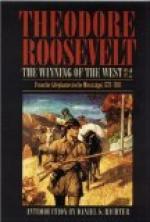this day. Mr. Edmund Kirke, for instance, usually
makes the absolute or relative numbers of the Indians
from five to twenty-five times as great as they really
were. Still, it is hard to blame backwoods writers
for such slips in the face of the worse misdeeds of
the average historian of the Greek and Roman wars
with barbarians.] The red men were fickle of temper,
and large bodies could not be kept together for a long
campaign, nor, indeed, for more than one special stroke;
the only piece of strategy any of their chiefs showed
was Cornstalk’s march past Dunmore to attack
Lewis; but their tactics and discipline in the battle
itself were admirably adapted to the very peculiar
conditions of forest warfare. Writers who speak
of them as undisciplined, or as any but most redoubtable
antagonists, fall into an absurd error. An old
Indian fighter, who, at the close of the last century,
wrote, from experience, a good book on the subject,
summed up the case very justly when he said:
“I apprehend that the Indian discipline is as
well calculated to answer the purpose in the woods
of America as the British discipline is in Flanders;
and British discipline in the woods is the way to have
men slaughtered, with scarcely any chance of defending
themselves.” [Footnote: Col. Jas.
Smith, “An Account,”
etc., Lexington,
Ky., 1799.] A comparison of the two victories gained
by the backwoodsmen, at the Great Kanawha, over the
Indians, and at Kings Mountain over Ferguson’s
British and tories, brings out clearly the formidable
fighting capacity of the red men. At the Kanawha
the Americans outnumbered their foes, at King’s
Mountain they were no more than equal; yet in the former
battle they suffered twice the loss they did in the
latter, inflicted much less damage in return, and
did not gain nearly so decisive a victory.
Twofold Character of the Revolution.
The Indians were urged on by the British, who furnished
them with arms, ammunition, and provisions, and sometimes
also with leaders and with bands of auxiliary white
troops, French, British, and tories. It was this
that gave to the revolutionary contest its twofold
character, making it on the part of the Americans
a struggle for independence in the east, and in the
west a war of conquest, or rather a war to establish,
on behalf of all our people, the right of entry into
the fertile and vacant regions beyond the Alleghanies.
The grievances of the backwoodsmen were not the same
as the grievances of the men of the seacoast.
The Ohio Valley and the other western lands of the
French had been conquered by the British, not the
Americans. Great Britain had succeeded to the
policy as well as the possessions of her predecessor,
and, strange to say, had become almost equally hostile
to the colonists of her own stock. As France
had striven for half a century, so England now in
her turn strove, to bar out the settlers of English
race from the country beyond the Alleghanies.
The British Crown, Parliament, and people were a unit




